
SUSTAINABLE
DEVELOPMENT
SIMULATION
|

The PelicanWeb's Journal of Sustainable Development
Research Digest on Integral Human Development,
Solidarity, Sustainability, and Related Global Issues
|
Vol. 6, No. 8, August 2010
Luis T. Gutierrez, Editor
|
|
|

|
|
|
Sustainable Development Simulation (SDSIM)
Version 1 - General Description
|

|
|
SUMMARY
The objective of the Sustainable Development Simulation (SDSIM) is to analyze trade-offs between human development and economic development priorities. It is a global model, in the tradition of Limits to Growth and other similar projects. However, it attempts to take into account both material resources, which are limited, and human resources such as human wisdom, which are unlimited. The time window is 1950-2200, and the transition from consumerism to sustainability is expected to happen during the 21st century (i.e., approximately 2010-2100).
SDSIM is a System Dynamics model, and it is programmed in the STELLA simulation language. Links are provided to the STELLA software and an excellent System Dynamics primer. However, it is assumed that the reader is familiar with the System Dynamics method of system analysis and synthesis. A description of the model is provided below in 9 sections:
1. The Sustainable Development Paradox
2. Sustainable Development Simulation Scenarios
3. SDSIM Version 1 Causal Loop Diagram
4. SDSIM Version 1 Detailed Model Diagram
5. SDSIM Version 1 Model Formulation & Documentation
6. SDSIM Version 1 Model User Interface
7. SDSIM Version 1 Simulation Experiments
8. SDSIM Version 1 Simulation Analysis & Synthesis
9. SDSIM Version 1 Limitations & Planned Extensions
This page provides an introduction and general overview of the SDSIM Version 1. The web-based user interface, and the detailed list of model equations, are provided in a separate page.
The model documented herein is Version 1, i.e., a test model intended for review and feedback pursuant to subsequent development of more mature models, and eventually a decomposition into global, national, and local levels.
SYSTEM DYNAMICS METHOD: The system dynamics method is minimally described - in conjunction with the general description of the SDSIM - in Sections 3 to 8 of this page. Readers who are unfamiliar with the system dynamics method may want to explore the following online resources:
Principles of Systems, Jay W. Forrester, Wright-Allen Press, 1968.
Counterintuitive Behavior of Social Systems, Jay W. Forrester, MIT, Tech Review, 1971.
The Limits to Growth, Meadows & Meadows, MIT, 1972
Feedback dynamics of secondary succession in ecosystems, Gutierrez & Fey, PNAS, 1975.
Ecosystem Succession, Gutierrez & Fey, MIT Press, 1980.
The Energy Transition and the Economy, John Sterman, MIT, 1982.
Beyond the Limits to Growth, Meadows & Meadows, Context Institute, 1992
System Dynamics Mega Link List, G. Ossimitz, Universität Klagenfurt, started 1997.
Intellectual Roots and Philosophy of System Dynamics, Willard R. Fey, EOLSS, 2001.
System Feedback Modeling for Policy Analysis,
Yaman Barlas, EOLSS, 2002.
System Dynamics Model Library, Tom Fiddaman, MetaSD, started 2002.
Limits To Growth: The 30-Year Update, Meadows & Meadows, Sustainability Institute, 2004.
Introduction to Systems Thinking, Barry Richmond, ISEE Systems, 2004.
The Energy Perspective: Oil and the Magical 4%, Fey, Gutierrez & Lam, EDL, 2005.
System Dynamics Society (SDS), Roberta Spencer, University of Albany, NY, 2010.
System Dynamics Review, John Wiley & Sons, 1985-2010.
Tracing Connections, Edited by Joy Richmond et al, ISEE Systems, 2010.
LINK TO REFERENCES & DATA SOURCES: Directory of Sustainable Development Resources
NOTE: Any suggestion for improving the definition of modeling requirements, the model design and formulation, the user interface, and the analysis and synthesis of the simulation results would be most welcome. To submit comments/suggestions/corrections please contact the journal editor.
|
FREE DOWNLOAD: To download the SDSIM, click on the button to the right. SDSIM requires STELLA 9.1.3 or higher. Readers who do not have the STELLA software can download a free one month trial from ISEE Systems.
|

|
|
|
1. The Sustainable Development Paradox
|
Sustainable development is a paradoxical undertaking. Ceteris paribus, continued population growth and economic development (in the sense of human consumption) are bound to exacerbate the process of biosphere degradation and climate dislocations. But, limiting population growth and economic development in order to mitigate - let alone reverse - environmental degradation are bound to exacerbate vexing issues of financial stability, poverty eradication, and social justice:
|
"Our enormously productive economy… demands that we make consumption our way of life, that we convert the buying and use of goods into rituals, that we seek our spiritual satisfaction, our ego satisfaction, in consumption… We need things consumed, burned up, worn out, replaced, and discarded at an ever increasing rate." Victor Lebow, 1955
|
In his latest book, Agenda for a New Economy: From Phantom Wealth to Real Wealth, David C. Koster argues forcefully for the need to redesign our financial and economic systems so that they are at the service of "Main Street" rather than "Wall Street." Perhaps a new economic system can be designed so that the sustainable development paradox vanishes. But, at the moment, we must start where we are.
The best definition and visualization of the sustainable development paradox may be that produced at the turn of the century by Willard R. Fey and Ann C.W. Lam of Ecocosm Dynamics Ltd. They use both concise text and a masterful diagram to discuss the paradox. The diagram is reproduced below:
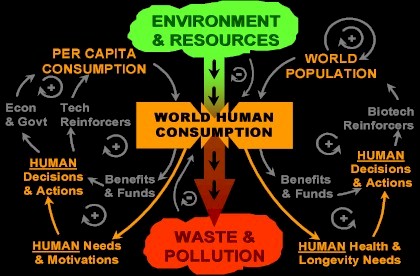
Visualization of the Sustainable Development Paradox
by Willard R. Fey and Ann C.W. Lam, Ecocosm Dynamics Ltd
Reprinted with Permission
The United Nations Millennium Development Goals (MDGs) is one of many initiatives that is suffering from the inability to resolve the paradox, and may fall short of the 2015 targets. In fact, there is a Summit on the Millennium Development Goals, scheduled for 20-22 September 2010, to attempt such a resolution by the United Nations General Assembly:
|
"We must not fail the billions who look to the international community to fulfill the promise of the Millennium Declaration for a better world. Let us meet in September to keep the promise." -- UN Secretary-General, Ban Ki-moon
|
The 20-22 September 2010 meeting will be at the ambassadorial level and will undoubtedly be supported by the best experts on the economic, social, and environmental repercussions of the MDGs. Independent researchers, and all global citizens of good will, would do well to keep track of this meeting and then proceed to reflection and analysis of the decisions taken by the General Assembly. In the meantime, this new supplement of the journal introduces a simulation tool that may be useful in elucidating the range of possible futures bound to emerge from continued pursuit of the MDGs and other sustainable development initiatives.
|
2. Sustainable Development Simulation Scenarios
|
A simulation scenario for the transition from consumerism to sustainability must include the recent past, the transition phase, and the long term future. For example:
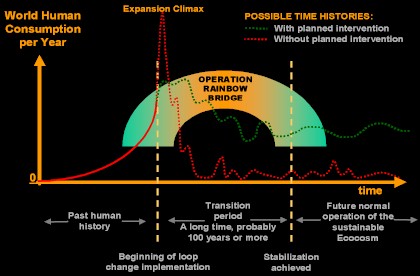
Visualization of the Transition from Consumerism to Sustainability
by Willard R. Fey and Ann C.W. Lam, Ecocosm Dynamics Ltd
Reprinted with Permission
In their conceptual scenario, Fey and Lam suggest 100 years for the transition phase, which they refer to as "Operation Rainbow Bridge."
In that the transition will entail institutional reformations and cultural evolution, 100 years (3 generations) is a very reasonable estimate. However, the decline in human consumption following the "expansion climax" might seem to be a bit too fast unless the "expansion climax" brings the global economic system to the point of total collapse. They show two possibilities: the red curve would seem to suggest an irreversible total collapse in which only a "remnant" of humanity remains alive during and beyond the transition phase. The green curve suggests that the collapse can be mitigated by human responsiveness and ecological resilience. After a crisis of such magnitude, it seems reasonable that both the green and red curves show some oscillations persisting for a long time. Things are never perfectly smooth during steady-state conditions, let alone during a growth-followed-by-collapse situation.
There are thousands of sustainable development scenarios floating around the web, and they show every conceivable level of maturity, i.e., number of persons-years invested in their development, allowance for variations, reproducibility, documentation, etc. A set of scenarios that have been under development since the early 1990s - initially by the Global Scenario Group (GSG) and more recently by the Great Transition Initiative (GTI) - may be the best set of scenarios to work with. They provide a range of possible scenarios, each one supported by a comprehensive database. The GSD/GTI taxonomy of scenarios is a follows:
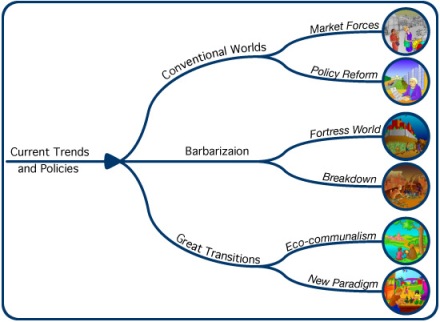
Taxonomy of the GSG/GTI Scenarios
P.Raskin, et al. Tellus Institute, 2008
Reprinted with Permission
For more information on these scenarios, see the following:
Global Scenario Results
Great Transition: The Promise and Lure of the Times Ahead
Global Scenarios for the Century Ahead: Searching for Sustainability
The reader may want to visit this taxonomy of scenarios and click on each one to see the supporting documentation, then proceed to the Global Scenario Results to explore the various options for retrieval of data pertaining to eleven regions (Africa, China+, Eastern Europe, FSU, Latin America, Middle East, North America, Pac OECD, South Asia, Southeast Asia, Western Europe, OECD regions, Non-OECD regions, and the World) and 105 variables related to demographics, economics, society, energy usage, agriculture, land use, water resources, air emissions, and solid waste. This may be the best set of scenarios for analysis of global/regional sustainable development futures.
The "conventional worlds" scenarios assume that the past will continue into the future; not a very realistic option. The "barbarization" scenarios assume that, under the pressure of an increasingly degraded human habitat, human civilization will regress to widespread violence and the "survival of the fittest"; not a very attractive proposition. The "great transition scenarios" assume that we may have to do a lot of "muddling through" but in the end new social and economic paradigms will emerge that in the long term will lead to a new steady-state of sustainable harmony between humanity and the human habitat; this is the path chosen as "baseline" for the SDSIM. Specifically, within the context of the "great transition scenarios," the SDSIM is being developed to support the resolution of the sustainable development paradox by setting economic development priorities in such a way that they support, and in fact reinforce, the most critical human development priorities: "humans need bread to live, but cannot live by bread alone."
|
3. SDSIM Version 1 Causal Loop Diagram
|
In the system dynamics method, the most critical step is to identify the feedback loop structure that generates the dynamic behavior to be understood and, perhaps, modified to improve system behavior. The polarity of feedback loops can have positive, negative, or variable polarity. A feedback loop with positive polarity generates growth or degrowth. A feedback loop with negative polarity compensates for deviations and maintains the stability of the system at a given equilibrium state. A feedback loop with variable polarity can switch from positive to negative polarity (or vice versa) when certain conditions are met. Feedback loop systems generally contain nonlinear relationships that often generate complex behavior patterns over time. Readers who are not familiar with the system dynamics method are encouraged to study the excellent primer Introduction to Systems Thinking, by Barry Richmond, ISEE Systems, 2004.
The causal loop diagram shown below attempts to capture, at a very high level, the essential feedback structure of the global system that must be dealt with during the transition from consumerism to sustainability. The arrows between any pair of nodes (say, A and B) show the assumed direction of causation between those nodes. Each causal link has a polarity - positive, negative, or variable. Arrows with a positive sign mean that if A increases, B increases, and if A decreases, B decreases. Arrows with a negative sign mean that if A increases, B decreases, and if A decreases, B increases. As any system dynamics practitioner knows, loops with zero or an even number of negative links have positive polarity and generate growth; and loops with an odd number of negative links have negative polarity and tend to maintain stability. So single loops are easy to understand. But when you are dealing with a plurality of loops with different polarities and interlocked in complex geometries, the modes of behavior arising from all the loops interacting together can become quite complex and hard to understand.
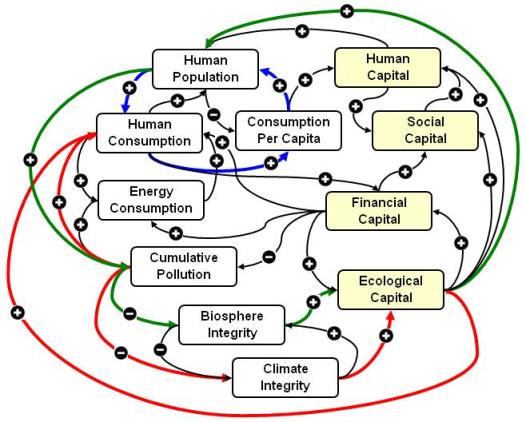
Causal Loop Diagram for the Sustainable Development Process
Arrows between any pair of nodes A and B show the assumed direction of causation
Arrows with a positive sign mean that if A increases, B increases, and if A decreases, B decreases
Arrows with a negative sign mean that if A increases, B decreases and if A decreases, B increases
Using the TouchGraph tool, the following links bring up a listing and relational map of web sites with content related to each of the above nodes:
Human Population,
Human Consumption,
Energy Consumption,
Cumulative Pollution,
Biosphere Integrity,
Climate Integrity,
Ecological Capital,
Financial Capital,
Social Capital,
Human Capital, and
Consumption per Capita.
The reader may want to explore web sites with content on related concepts such as
Human Development,
Social Development, and
Economic Development.
|
Each node must be meaningful and measurable. Each link and each loop must describe how the nodes interact in the real world. Consider, for example, the loop highlighted in green, starting and ending in human population. This loop is a growth loop until growth reaches the limits of ecological capital (i.e., ecosystem services); then it remains positive but further growth is constrained. Next, consider the loop highlighted in red, starting and ending in human consumption. This loop is a negative loop, with climate integrity acting as the stabilizing factor. However, if climate integrity declines, the loop is weakened and may, in fact, become destabilizing. Finally, consider the loop highlighted in blue, starting and ending in human population. This is the mythical loop of economic growth; except that, if consumption per capita decreases and approaches zero, it would become the loop of rapid degrowth. These are the kinds of loops that have been analyzed extensively by Donella and Dennis Meadows in The Limits to Growth (1972, 1991, 2004).
The main focus of SDSIM, however, is on the interactions between the nodes highlighted in yellow: ecological capital, financial capital, social capital, and human capital. Ecological capital stands for ecosystem services. Financial capital is money (as opposed to real wealth). Social capital stands for the degree of social cohesion and solidarity. Human capital stands for the degree of human development as could be measured, for example, by the percentage of the population that has ascended to the fourth and fifth levels of Maslow's Hierarchy of Needs. During the transition from consumerism to sustainability, how should resources (financial and otherwise) be allocated to economic growth versus human development? From the perspective of sustainable development, which one is more important, economic development or human development?
|
4. SDSIM Version 1 Detailed Model Diagram
|
The diagram below translates the causal loop diagram of the previous section into a detailed STELLA flow chart amenable to implementation as a computer simulation program. Briefly, the rectangles are levels (stocks, accumulations, integrations). The valves in the thick arrows are the rates (flows) that go into and out of the levels. When the inflow is greater than the outflow, the level grows. When the inflow is smaller than the outflow, the level declines. When the inflow and the outflow are the same, the level does not change. The circles are either constants (e.g., conversion factors) or functions used in the formulation of the rates as functions of the levels at each point in time. The thin arrows show how the rates are formulated as functions of the levels. In the SDSIM model, the unit of time is the calendar year, the starting time is 1950 and the ending time is 2200. Thus the recursive level-rate calculations are performed 250 times, corresponding to years 1950, 1951 .... 2199, 2200.
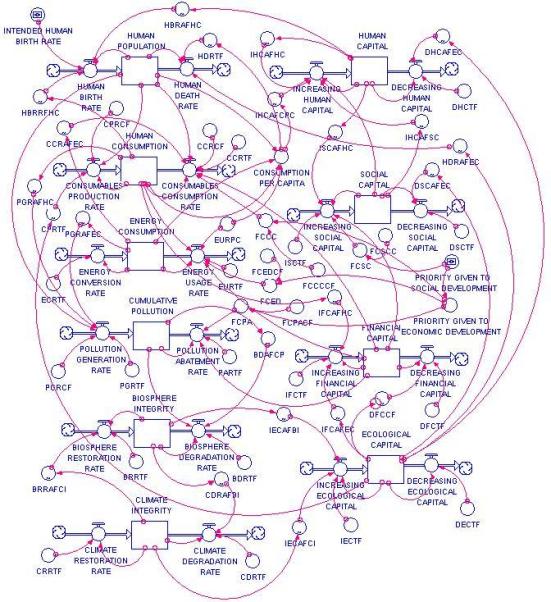
STELLA Flow Diagram of SDSIM Version 1
RECTANGLES are LEVELS (cumulatives), VALVES are RATES (flows),
CIRCLES are variables or constants used to formulate the RATES as functions of the LEVELS
at TIME = t for the iteration t+dt, where t=1950, 1951, .... 2199, 2200 and dt=1
The circles with the slider image inside are the two variables currently accessible to manipulation by users (via the user interface to be described in Section 6):
1. PRIORITY GIVEN TO HUMAN DEVELOPMENT
The objective of this user decision is to explore the effect of allocating financial resources to human development versus economic development. To this end, it is assumed that:
Priority given to Human Development = 1 - Priority given to Economic Development
In other words, the fraction allocated to human development and the fraction allocated to economic development must add up to 1. Thus the range of the priority given to human development is 0 to 1. Selecting 1 means that 100% of capital investment is allocated to social and human development. Selecting 0 means that 100% of capital investment is allocated to economic growth and pollution mitigation. Selecting 0.5 means that 50% goes to economic growth and 50% goes to social/human development. The default value is 0.25.
2. INTENDED HUMAN BIRTH RATE
The range of allowable values for intended human birth rate is 0.03 to 0.09. The default value is 0.065. This translates (after some crude demographic calculations) to approximately 1.18% growth per year (the average growth per year from 2001 to 2009) assuming an average life expectancy is 50 years. Starting with 2.5 billion as of 1950, setting the intended human birth rate at 0.065 calibrates the total human population to reach 6.8 billion by 2010.
|
5. SDSIM Version 1 Model Formulation & Documentation
|
There are ten level equations:
HUMAN POPULATION (persons)
HUMAN CONSUMPTION (real value dollars)
ENERGY CONSUMPTION (million tons of oil equivalent - MTOE)
CUMULATIVE POLLUTION (parts per million by volume - PPMV)
BIOSPHERE INTEGRITY (percentage of pristine biomass/biodiversity)
CLIMATE INTEGRITY (percentage of pristine stabilizing capacity)
ECOLOGICAL CAPITAL (percentage of pristine ecosystem services)
FINANCIAL CAPITAL (total dollars - both phantom wealth and real wealth)
SOCIAL CAPITAL (percentage of the population that practice solidarity/gender equality)
HUMAN CAPITAL (percentage of the population in the 4th and 5th Maslow levels)
Mathematically, the level equations are of the form

or, in difference equation notation,
LEVEL(t) = LEVEL(t-dt)+dt*[input rate(t) - output rate(t)]
and the rate equations are of the form

or, in algebraic notation,
RATE(t) = f [constants and functions of LEVELS(t)]
NOTE: SUPPORTING TEXT FOR EACH EQUATION IS TBD

|
For a detailed listing of the SDSIM model equations,
click HERE
|
|
6. SDSIM Version 1 Model User Interface
|
The following is an image of the SDSIM Version 1 user interface. For the web-based user interface where the reader can run the simulation and manipulate two decision variables, click HERE (FORIO SIMULATE) or click HERE (PELICAN WEB). For a preliminary guide to the user interface, click HERE.
Image of the SDSIM Version 1 User Interface
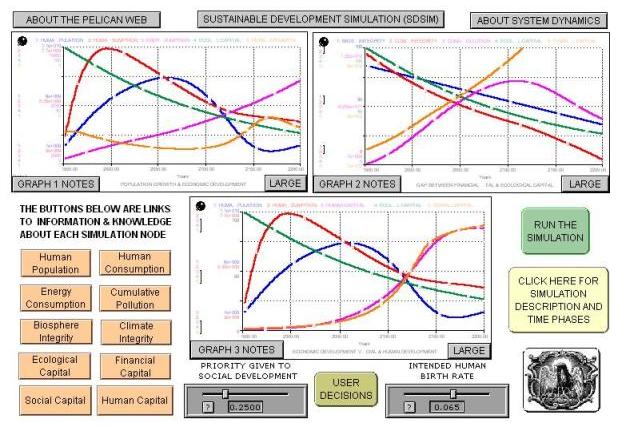
To access the operational web-based user interface,
click on the above image or click HERE
The user interface currently allows manipulation of two decision variables:
PRIORITY GIVEN TO SOCIAL/HUMAN DEVELOPMENT and INTENDED HUMAN BIRTH RATE
Clicking on the icons brings up supporting text about SDSIM, the simulation graphs, and the decision variables
The user interface is currently hosted by the Forio Simulations web site.
It is also operational in the Pelican Web.
NOTE: ADDITIONAL SUPPORTING TEXT FOR THE USER INTERFACE IS TBD
|
7. SDSIM Version 1 Simulation Experiments
The Sustainable Development Simulation (SDSIM) model takes into account demographic, economic, social, financial, and ecological factors. It includes both material flows and human decisions on the allocation of resources to economic growth versus social/human capital.
Version 1 is a test model, and only the population growth curve has been calibrated to fit 1950-2010 world population data. For more information and current status (updated monthly) on this model, go to the Pelican Web home page and click on the SDSIM link.
SDSIM is intended to be used in a "backcasting" mode. In other words, SDSIM Is not about predicting the future. It is about defining what kind of future we want, and then working backwards to see what kinds of human decisions and behavior are required in order to bring about the kind of world we want to have. The simulation graphs inserted below have three phases:
1950-2010: This is the past, so there is nothing we can do about it.
2100-2200: This is the future we want to ensure in order to attain a healthy balance between humanity and the human habitat.
2010-2100: This is the window of opportunity. Both social and ecological time constants are very long, and the explosive growth of the second half of the 20th century, driven by a Wall Street economy, will have repercussions during the 21st and 22nd centuries and beyond. If we want to attain a transition from a Wall Street to a Main Street economy, and a semblance of harmony between humanity and the human habitat, the years from 2010 to 2100 is the time to accomplish the transitions from patriarchy to solidarity, consumerism to sustainability, and imperialism to subsidiarity.
|
|
We are now faced with the fact that tomorrow is today.
We are confronted with the fierce urgency of now.
In this unfolding conundrum of life and history
there is such a thing as being too late.
Procrastination is still the thief of time...
We must move past indecision to action...Now let us begin.
Now let us rededicate ourselves to the long and bitter
-and beautiful- struggle for a new world.
This is the calling of the children of God,
And our brothers and sisters wait eagerly for our response.
Shall we say the odds are too great?
Shall we tell them the struggle is too hard?
... Or will there be another message,
of longing, of hope, of solidarity with their yearning,
of commitment to the cause, whatever the cost?
The choice is ours, and though we might prefer it otherwise
we must choose in this crucial moment in human history.
Martin Luther King, Jr. (1929-1968)
|
|
The three plots shown below come from the same simulation (the "baseline" simulation):
- Transition dynamics of human population, human consumption, energy consumption, consumption per capita, and ecological capital (economic development focus)
- Transition dynamics of cumulative pollution, biosphere integrity, climate integrity, ecological capital, and financial capital (environmental management focus)
- Transition dynamics of human population, human consumption, human capital, social capital, and ecological capital (social/human development focus)
SDSIM V1 Simulation Results - Graph 1
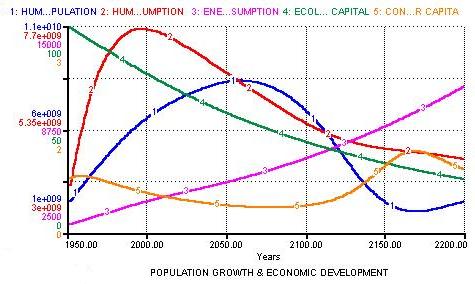
Human Population & Economic Development Perspective
Shows the transition dynamics of HUMAN POPULATION (BLUE), HUMAN CONSUMPTION (RED),
ENERGY CONSUMPTION (PINK), ECOLOGICAL CAPITAL (GREEN), and CONSUMPTION PER CAPITA (YELLOW)
To view an LARGER image of the simulation plot, click HERE
The simulation shows that the actual (as opposed to the dollar) value of consumables (red curve) started decreasing after 2000. Population (blue curve) then decreases as basic goods and services are not available to meet human needs. Note that consumption per capita (yellow curve) has been decreasing since about the 1970s and only rebounds after 2100, when consumption has stabilized and population is at the lowest level. It is well known that, starting during the 1970s, productivity has grown mush faster than wages, so perhaps it is not surprising that working people have experienced a decline in their ability to but real goods and services with their dollars. Isn't this a case of transferring wealth from Main Street to Wall Street, i.e., from the poor and very poor to the very rich? And isn't this a case of transferring wealth from Nature Street to Wall Street by the trick of treating environmental costs and ecosystem services as "externalities" for which Wall Street never pays? Sooner or later, humanity will have to pay for the decline of ecosystem capital (green curve). The exponential growth in the consumption of energy (pink curve) is feasible if adequate resources are allocated to developing sources of clean energy (solar, wind, etc.) so that there can be a massive shift from burning fossil fuels to using clean energy. Then we can have clean manufacturing, clean transportation, etc.
SDSIM V1 Simulation Results - Graph 2
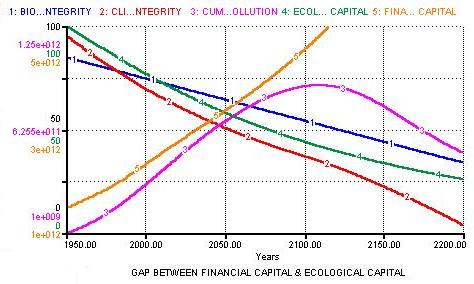
Ecology, Pollution, and Environmental Management Perspective
Shows the transition dynamics of BIOSPHERE INTEGRITY (BLUE), CLIMATE INTEGRITY (RED),
CUMULATIVE POLLUTION (PINK), ECOLOGICAL CAPITAL (GREEN), and FINANCIAL CAPITAL (YELLOW)
To view an LARGER image of the simulation plot, click HERE
Cumulative pollution (pink curve) is the accumulation of pollution dumped on the natural environment and not recycled by either natural or technical means. The simulation shows cumulative pollution increasing and not peaking until the 22nd century; then it starts decreasing in response to decreasing rates of population and consumption growth. Biological integrity (blue curve) includes the combined product total of biomass and biodiversity. It ecreases linearly in response to cumulative pollution. Climate integrity (red curve) including temperature, precipitation, etc. show a nonlinear response to biosphere degradation, specially after 2150. Ecological capital (green curve) is a combination of biosphere and climate integrity, and dcreases exponentially as a result of biosphere and climate degradation. It is noteworthy that financial capital (including both real and phantom wealth) keeps growing exponentially while ecological capital (ecosystem services) are depleted in response to human consumption and environmental degradation.
SDSIM V1 Simulation Results - Graph 3
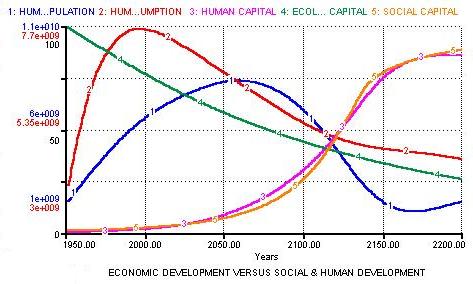
Economic Development versus Social/Human Development Perspective
Shows the transition dynamics of HUMAN POPULATION (BLUE), HUMAN CONSUMPTION (RED), HUMAN CAPITAL (PINK), ECOLOGICAL CAPITAL (GREEN), and SOCIAL CAPITAL (YELLOW)
To view an LARGER image of the simulation plot, click HERE
The exponential decay of ecological capital (green curve) is worrisome, but biota can bounce back, at least to some extent - a process called "ecological succession." It is in fact conceivable that, with good conservation and agricultural practices, ecosystems can bounce back to full health albeit not necessarily back to their pristine form. But what really matters in this plot are the social capital (yellow curve) and human capital (pink curve). The transition must be one in which social cohesion and human development grow to very high sustainable levels, with a high percent of the population up in the 4th and 5th levels of Maslow's Pyramid of Human Needs. For these hight levels of social and human capital to be achieved and be sustainable, human population (blue curve) and human consumption (red curve) must decline to allow ecological capital (green curve) to settled to a new steady state that - successional recoveries and technological enrichment notwithstanding - is bound to be much lower than the pristine ecosystem services provided by the unperturbed planet. Bottom line: the transition from consumerism to sustainability is achievable, and high levels of social and human development are sustainable, albeit at the price of reduced human population, reduced human consumption, and high prioritization of financial investment for social/human development.
In brief, the simulations confirm that there are material limits to growth. Technological advances might allow for adjusting the limits, but the fact remains that it is impossible to have unlimited growth in a limited planet. Energy consumption appears to grow without limits by assuming that conversion from fossil fuels to clean sources of energy. If solar energy is included in the energy mix, then for all practical purposes energy consumption becomes unlimited relative to materials consumption that are constrained by recycling times. Financial capital also can grow indefinitely as long as it includes both phantom wealth and real wealth. Wall Street banks can create as much phantom wealth as they want by simply creating money via accounting entries, and the possibility of paper becoming limiting for printing the money does not seem to be an issue at the moment -- if the world has to go paperless, they can keep generating money electronically. Finally, the simulations suggest that it might take a century to increase social and human capital to the point in which a large percentage (say, 80% or more) of the human population has reached the upper levels of Maslow's human development hierarchy.
NOTE: THE FORMULATIONS OF SOCIAL AND HUMAN CAPITAL ARE STILL VERY TENTATIVE.
|
8. SDSIM Version 1 Simulation Analysis & Synthesis
|
ANALYSIS
Analysis of the simulations entails explaining the simulated behavior by reference to the feedback loop structure of the system. At a high level, all the "gibberish" in the STELLA flow diagram (Section 4) can be avoided by referring back to the causal loop diagram (Section 2).
The causal loop diagram is reproduced below, with some loops shaded to facilitate the narrative. Basically, the outermost sets of loops (shaded in green) are inactive as long as ecological capital is high, but become limiting when ecological capital depletes to a low level. This might seem obvious, but Dennis and Donella Meadows deserve much credit for bringing this reality to the attention of all global citizens with their initial (1972) publication of The Limits to Growth.
Most of the inner loops remain dormant during the simulation. Specifically, the loop between financial capital and ecological capital (shaded in gray) is practically dead. This is so because the model does not distinguish between reversible and irreversible ecological capital depletion. Actually, in the current system, ecological capital depletion is treated as an "externality" that is irrelevant to the financial sector. As long as this is the way the real financial system works, there is no modeling incentive to dig deeper in this area. However, if financial reform eliminates the "externalities" trick, then it would be worthwhile to investigate the extent to which ecological capital depletion can be reversed by investing in appropriate ecosystem recovery technologies.
The loop shaded in orange is the basic economic growth engine. In a consumerist culture, this positive feedback loop would grow exponentially until constrained by the collateral damage caused by toxic pollution and the depletion of ecosystem services by the unregulated usage of natural resources, both renewable and non-renewable. But note that the orange loop is embedded within a larger orange/brown loop that couples the economic system with the social and political systems. At this point in human history, there is no "political will" to moderate consumerist priorities in order to focus on what really matters: social and human development. Therefore, the brown side of the orange/brown loop is very weak and, as long as this remains so, GDP will continue to increase, the rich-poor gap will continue to widen ("big fish eats small fish"), and very few people will develop their full human potential (human capital) to the point of demanding politicians to free themselves from the Wall Street economy in order to embrace the Main Street economy.
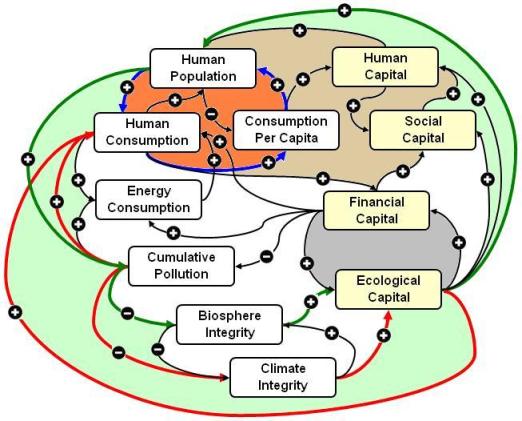
Causal Loop Diagram Visualization of the Simulation Analysis and Synthesis
ANALYSIS
The nested loop shaded in orange is the driver of exponential economic growth
The nested loops shaded in orange/brown are the dominant loops for sustainable development
The nested loop shaded in gray has no discernable influence on ecological capital
The outermost loops (shaded in green) become limiting when ecological capital is depleted
SYNTHESIS
The transition from consumerism to sustainability requires a shift
in dominance from the orange loop to the total orange/brown loop
SYNTHESIS
The transition from consumerism to sustainability requires a shift in dominance from the orange loop to the total orange/brown loop. How could this shift be accomplished? Mitigation of population growth is necessary, but not sufficient; for "the bed is the consolation of the poor" and the poor - those who are barely surviving in the bottom level of Maslow's pyramid - cannot be expected to reduce birth rates by either natural or artificial means. Somehow, economic incentives will have to be reformed so that education of the poor, and social/human development initiatives, become as profitable as making and selling widgets to those who can pay for them.
In the context of SDSIM, this will require deeper analysis of the orange/brown loop in order to elucidate how peoples and governments might steer the economic system so that it becomes both economically and socio-politically profitable. This is "where the rubber meets the road." Easier said than done, but this is the splendid challenge that is being offered to the community of "world system thinkers."
|
9. SDSIM Version 1 Limitations & Planned Extensions
|
SDSIM Version 1 is a prototype for SDSIM. In other words, it is a test model. It could be used as a teaching tool or as focal point for discussion. But a significant amount of model verification and validation work will be required before it is ready for decision-making support of policy support. It is presently offered version for review and evaluation by the community of world system thinkers and scholars. In order to facilitate searching for information/knowledge pursuant to providing feedback, the following is a list of links to TouchGraphs of web content related to each of the ten nodes in the current model:
Each TouchGraph has a search box to get a revised list and map of web sites containing relevant content. For instance, "human development" might be used instead of "human capital," or "biomass biodiversity" might be used instead of "biosphere integrity." Lists of pending issues and planned enhancements are provided below.
The following is a list of pending issues:
- Is "what are the priorities for human development versus economic development" the right question to ask?
- Is "what are the priorities for mitigation versus adaptation strategies another important question to consider?
- Are there other important questions that should be considered for Versions 2+?
- The modeling context is a mix of data-rich and data-poor situations. There is abundant data for the economic and ecological sectors, but there is a paucity of data for the social and human capital sectors (e.g., "political will").
- The model is primarily intended for "qualitative" analysis rather than "quantitative" forecasting. Need to make this clear.
- Only the human population curve is calibrated to real world data (1950-2010). Need data for initial conditions in the other material levels
- Need to articulate a meaningful interpretation of numerical values in the percentage levels (biosphere integrity, climate integrity, ecological integrity, social capital, human capital).
- Need to articulate how is the model to be used in a "backcasting" mode during the period 2010-2100. There must be switches that trigger policy changes at time = 2010, 2020, 2030, 2040, 2050, ....
- Use of Maslow's hierarchy of needs as the basis for interpretation of human capital.
- Use of gender equality indices (and other indices of social cohesion) as the basis for interpretation of social capital.
- Clear differentiation between real financial capital (real wealth) and volatile financial capital (phantom wealth).
- What version of "US Dollars" should be used for human consumption?
- What version of "US Dollars" should be used for financial capital?
- How to find a significant sample of interested/competent reviewers? Options include the pelicanweb subscribers, forums such as "World Systems Thinking," online surveys (effectiveness?)
The following is a list of planned refinements and extensions:
- Verification and validation of SDSIM objective(s)
- Verification and validation of the SDSIM user interface
- Verification and validation of SDSIM initial conditions as of 1950, simulated values as of 2010.
- Verification and validation of the SDSIM causal loop diagram(s)
- Verification and validation of the SDSIM STELLA diagram(s)
- Verification and validation of the SDSIM STELLA equations, conversion factors, and nonlinear functions
- Verification and validation of the SDSIM simulated behavior modes
- Verification and validation of the SDSIM simulation analysis and synthesis
- Identification of potential users (decision makers, policy makers) via expressions of interest
- Identification of institutional reformations required during the transition from consumerism to sustainability
- Definition of module interfaces for the fractal world-nations-localities structure (nesting hierarchy).
- Gathering and synthesis of feedback by reviewers and potentially interested users.
The next step is to find interested/competent reviewers.
|
|
|Back to OUTLINE|
|Back to SECTION 1|
|Back to SECTION 2|
|Back to SECTION 3|
|Back to SECTION 4|
|Back to SECTION 5|
|Back to SECTION 6|
|Back to SECTION 7|
|Back to SECTION 8|
|Back to SECTION 9|
Page 1
Supplement 1
Supplement 2
Supplement 3
Supplement 4
PelicanWeb Home Page
|
|
"Those who do not remember the past
are condemned to repeat it."
George Santayana,
The Life of Reason, 1905
|
|
Supplement 3
|
|
FREE SUBSCRIPTION
|
![[groups_small]](groups_small.gif)
|
Subscribe to the
PelicanWeb's Journal of
Sustainable Development
via the Solidarity-Sustainability Group
Enter your email address:
|
|
|
|